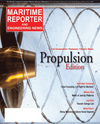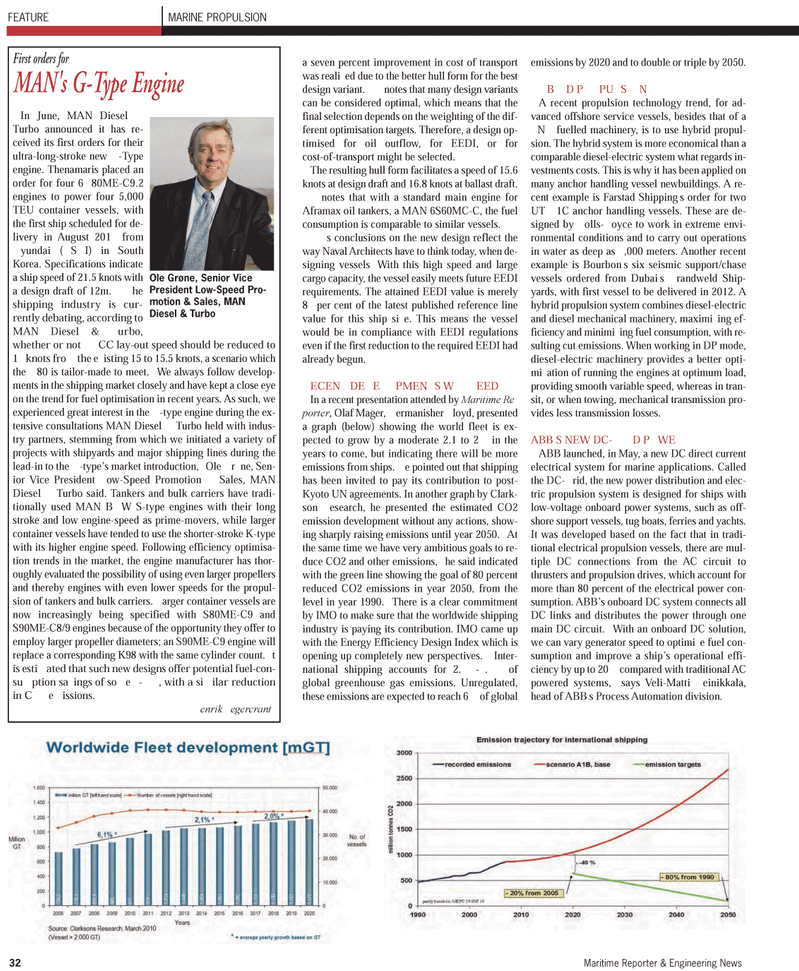
Page 32: of Maritime Reporter Magazine (September 2011)
Marine Propulsion Annual
Read this page in Pdf, Flash or Html5 edition of September 2011 Maritime Reporter Magazine
32Maritime Reporter & Engineering News a seven percent improvement in cost of transport was realied due to the better hull form for the best design variant. notes that many design variants can be considered optimal, which means that thefinal selection depends on the weighting of the dif- ferent optimisation targets. Therefore, a design op- timised for oil outflow, for EEDI, or for cost-of-transport might be selected.The resulting hull form facilitates a speed of 15.6 knots at design draft and 16.8 knots at ballast draft. notes that with a standard main engine for Aframax oil tankers, a MAN 6S60MC-C, the fuel consumption is comparable to similar vessels. s conclusions on the new design reflect the way Naval Architects have to think today, when de- signing vessels With this high speed and large cargo capacity, the vessel easily meets future EEDI requirements. The attained EEDI value is merely 8 per cent of the latest published reference line value for this ship sie. This means the vessel would be in compliance with EEDI regulations even if the first reduction to the required EEDI had already begun. ECEN DEEPMENS W EED In a recent presentation attended by Maritime Reporter, Olaf Mager, ermanisher loyd, presented a graph (below) showing the world fleet is ex- pected to grow by a moderate 2.1 to 2 in the years to come, but indicating there will be more emissions from ships. e pointed out that shipping has been invited to pay its contribution to post- Kyoto UN agreements. In another graph by Clark- son esearch, he presented the estimated CO2 emission development without any actions, show- ing sharply raising emissions until year 2050. At the same time we have very ambitious goals to re- duce CO2 and other emissions, he said indicated with the green line showing the goal of 80 percent reduced CO2 emissions in year 2050, from thelevel in year 1990. There is a clear commitment by IMO to make sure that the worldwide shipping industry is paying its contribution. IMO came up with the Energy Efficiency Design Index which is opening up completely new perspectives. Inter- national shipping accounts for 2.-. of global greenhouse gas emissions. Unregulated, these emissions are expected to reach 6 of global emissions by 2020 and to double or triple by 2050.BD PPUSN A recent propulsion technology trend, for ad-vanced offshore service vessels, besides that of a N fuelled machinery, is to use hybrid propul- sion. The hybrid system is more economical than a comparable diesel-electric system what regards in- vestments costs. This is why it has been applied on many anchor handling vessel newbuildings. A re- cent example is Farstad Shippings order for two UT1C anchor handling vessels. These are de- signed by olls-oyce to work in extreme envi- ronmental conditions and to carry out operationsin water as deep as ,000 meters. Another recent example is Bourbons six seismic support/chase vessels ordered from Dubais randweld Ship- yards, with first vessel to be delivered in 2012. A hybrid propulsion system combines diesel-electricand diesel mechanical machinery, maximiing ef- ficiency and minimiing fuel consumption, with re- sulting cut emissions. When working in DP mode, diesel-electric machinery provides a better opti- miation of running the engines at optimum load, providing smooth variable speed, whereas in tran- sit, or when towing, mechanical transmission pro- vides less transmission losses. ABBS NEW DC-D PWE ABB launched, in May, a new DC direct current electrical system for marine applications. Calledthe DC-rid, the new power distribution and elec- tric propulsion system is designed for ships withlow-voltage onboard power systems, such as off- shore support vessels, tug boats, ferries and yachts. It was developed based on the fact that in tradi- tional electrical propulsion vessels, there are mul- tiple DC connections from the AC circuit to thrusters and propulsion drives, which account for more than 80 percent of the electrical power con- sumption. ABB?s onboard DC system connects all DC links and distributes the power through one main DC circuit. With an onboard DC solution, we can vary generator speed to optimie fuel con- sumption and improve a ship?s operational effi- ciency by up to 20 compared with traditional AC powered systems, says Veli-Matti einikkala, head of ABBs Process Automation division. FEATURE MARINE PROPULSIONFirst orders for MAN's G-Type Engine In June, MAN Diesel Turbo announced it has re- ceived its first orders for their ultra-long-stroke new -Type engine. Thenamaris placed an order for four 680ME-C9.2 engines to power four 5,000 TEU container vessels, with the first ship scheduled for de- livery in August 201 from yundai (SI) in South Korea. Specifications indicate a ship speed of 21.5 knots witha design draft of 12m.heshipping industry is cur- rently debating, according to MAN Diesel & urbo, whether or not CC lay-out speed should be reduced to 1 knots fro the eisting 15 to 15.5 knots, a scenario whichthe 80 is tailor-made to meet. We always follow develop- ments in the shipping market closely and have kept a close eye on the trend for fuel optimisation in recent years. As such, we experienced great interest in the -type engine during the ex- tensive consultations MAN Diesel Turbo held with indus- try partners, stemming from which we initiated a variety of projects with shipyards and major shipping lines during the lead-in to the -type?s market introduction, Ole rne, Sen- ior Vice President ow-Speed Promotion Sales, MAN Diesel Turbo said. Tankers and bulk carriers have tradi- tionally used MAN BW S-type engines with their long stroke and low engine-speed as prime-movers, while larger container vessels have tended to use the shorter-stroke K-type with its higher engine speed. Following efficiency optimisa- tion trends in the market, the engine manufacturer has thor- oughly evaluated the possibility of using even larger propellers and thereby engines with even lower speeds for the propul- sion of tankers and bulk carriers. arger container vessels are now increasingly being specified with S80ME-C9 and S90ME-C8/9 engines because of the opportunity they offer to employ larger propeller diameters; an S90ME-C9 engine will replace a corresponding K98 with the same cylinder count. tis estiated that such new designs offer potential fuel-con- suption saings of soe -, with a siilar reduction in C eissions. enrik egercrant Ole Grøne, Senior Vice President Low-Speed Pro- motion & Sales, MANDiesel & Turbo

 31
31

 33
33
